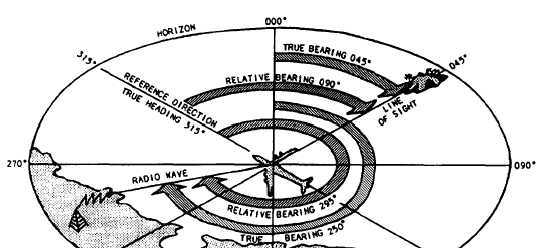. Course is the intended horizontal direction of
travel.
. Heading is the horizontal direction in which an
aircraft is pointed. Heading is the actual orientation
of the longitudinal axis of the aircraft at any instant,
while the course is the direction intended to be made
good.
. Track is the actual horizontal direction made
by the aircraft over the earth.
. Bearing is the horizontal direction of one point
to another (fig. 2-6). The direction of the island from
the aircraft is marked by the line of sight (visual
bearing). Bearings are usually expressed in terms of
one of two reference directions: (1) true north, or (2)
the direction in which the aircraft is pointed. If true
north is being used as the reference, the bearing is
called a true bearing. If the heading of the aircraft is
the reference, the bearing is called a relative bearing.
DEAD RECKONING
Dead reckoning (DR) navigation is a very simple
way of navigating.
It uses speed and heading
measurements to compute position changes from an
initial position fix.
One of the oldest automatic
navigation systems is the dead reckoning analyzer,
which takes its speed from the ship’s log and its
heading from the ship’s gyrocompass to compute
latitude and longitude.
The error in dead reckoning, as a percentage of
distance traveled, commonly reaches 2 to 5 percent.
As the distance between fixes increases, the accuracy
of the dead reckoning must be increased to maintain a
small absolute position error.
The two major causes of error in position
computed by dead reckoning are errors in the
measurements of heading and speed. A heading error
of 1 degree introduces an error of 1.75 percent of
distance traveled. A speed error of 1 percent
introduces an error of 1 percent of distance traveled.
The total system error becomes about 2 percent of
distance traveled. Increasing the accuracy of the
speed and heading measurements will increase the
system accuracy.
The various methods of dead reckoning and the
devices that are used are described in detail in
Aviation Electronics Technician 2 (Organizational),
NAVEDTRA 12330. It is strongly recommended that
you take the AT2(0) Nonresident Training Course,
NAVEDTRA 82330, to get a better understanding of
the above information.
ELECTRONIC ASSISTED NAVIGATION
While a navigator can successfully navigate an
aircraft using basic mechanical instruments and the
dead reckoning procedures, the use of electronic
positioning equipment will greatly increase the
accuracy of the navigation. The various fixing
devices such as loran, TACAN, omega, VOR, etc.,
will be discussed in detail later in this chapter.
Figure 2-6.-Measuring true and relative bearing.
2-6





